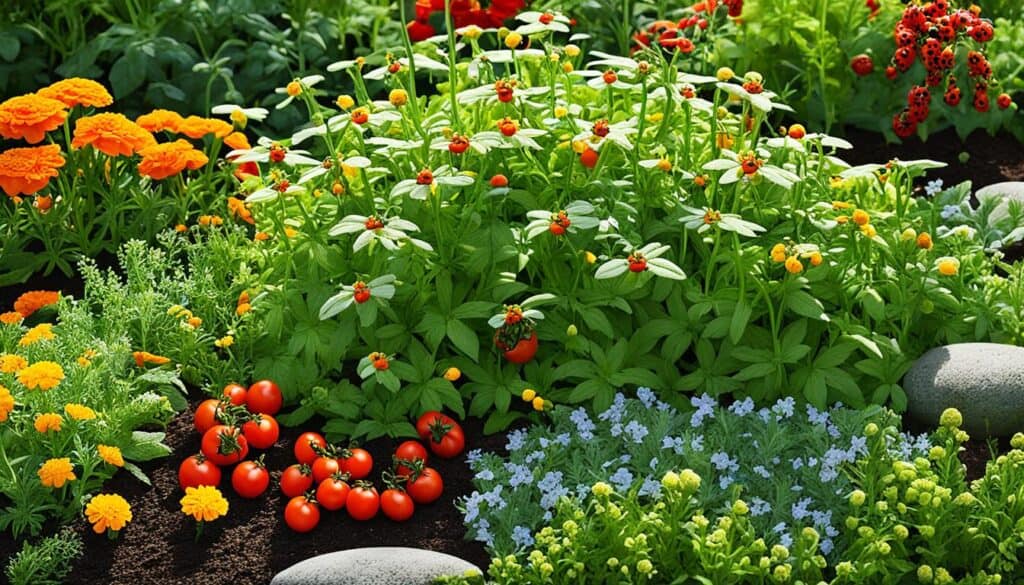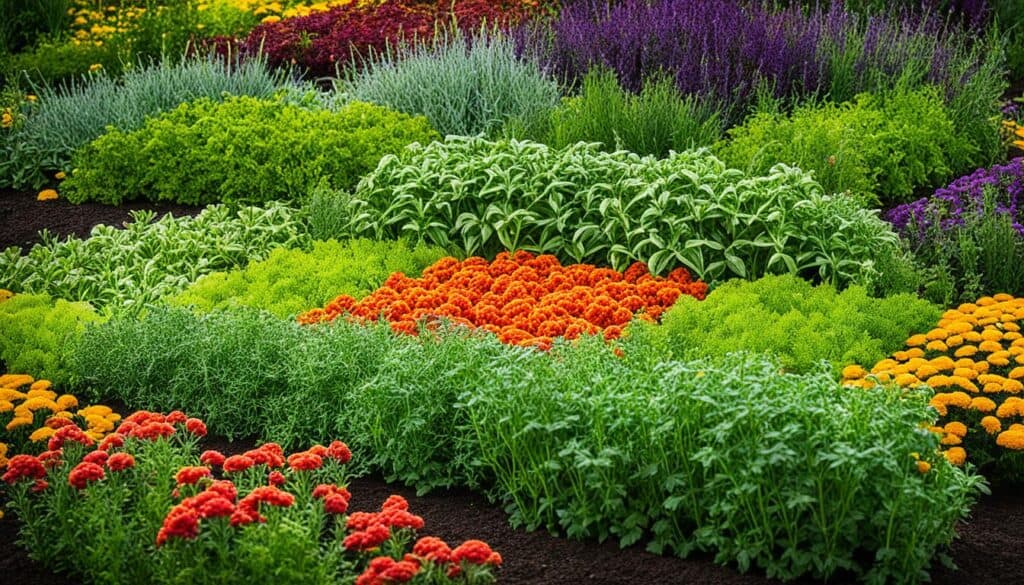Did you know that planting companion plants alongside tomatoes can significantly increase their growth and overall health? It’s true! Companion planting is a technique used by gardeners to maximize the potential of their tomato plants, and the results can be astounding. By strategically choosing the right companion plants, you can enhance nutrient uptake, control pests, improve pollination, and ultimately increase your tomato crop production. In this guide, I will introduce you to the benefits of companion planting and provide a comprehensive list of the best companion plants for your tomatoes.
Key Takeaways:
- Companion planting can greatly benefit tomato plants by improving nutrient uptake, pest control, and pollination.
- Choosing the right companion plants can create a diverse and thriving ecosystem in your tomato garden.
- Modern companion planting is based on scientific research and takes a more informed approach.
- Tomato companion plants for pest control can effectively reduce damage and protect your tomato crops.
- Companion plants that attract beneficial insects can help manage pests naturally and promote a balanced ecosystem.
The Benefits of Companion Planting
Companion planting offers numerous benefits for tomato plants. By strategically choosing companion plants, gardeners can create a diverse and thriving ecosystem in their tomato gardens. Let’s explore some of the key benefits that companion planting has to offer:
Pest Control
Companion plants can help control pests by repelling harmful insects or attracting beneficial ones that prey on pests. For example, planting marigolds alongside tomatoes can repel nematodes, while attracting spiders and ladybugs that feed on pest insects. This natural pest control approach helps reduce the need for chemical pesticides and promotes a healthier garden environment.
Soil Improvement
Certain companion plants have the ability to improve soil fertility and structure. For instance, planting legumes like beans or peas alongside tomatoes can fix nitrogen in the soil, making it more readily available to the tomato plants. Additionally, deep-rooted plants like dandelions or yarrow can break up compacted soil, allowing water and nutrients to reach the tomato plants more effectively.
Weed Control
Companion plants can also provide natural weed control in tomato gardens. Fast-growing plants with dense foliage, such as basil or marigolds, can help shade out weeds and reduce competition for resources. This helps keep the garden beds clean and minimizes the need for excessive manual weeding.
Pollination Enhancement
Some companion plants can enhance pollination in tomato gardens. Blooming plants like borage or calendula attract bees and other pollinators, increasing the chances of successful pollination for tomato flowers. This leads to higher fruit set and improved overall yield.
Health and Resilience
Companion plants contribute to the overall health and resilience of tomato plants. They can help improve air circulation, reduce disease pressure, and create a balanced ecosystem that supports beneficial microbial activity in the soil. This, in turn, enhances the vigor and vitality of the tomato plants, making them more resistant to pests, diseases, and environmental stressors.
By harnessing the benefits of companion planting, tomato gardeners can create a harmonious and productive growing environment for their plants. Now let’s take a closer look at some specific companion plants that work well with tomatoes:
| Companion Plant | Benefits |
|---|---|
| Alyssum | Attracts beneficial insects, such as lacewings and syrphid flies, which prey on pest insects. |
| Marigolds | Repel nematodes and attract spiders and ladybugs, aiding in pest control. |
| Basil | Improves the flavor of tomatoes and repels pests like aphids and whiteflies. |
| Borage | Attracts bees and other pollinators, enhancing tomato pollination and fruit set. |
| Dill | Attracts beneficial insects, such as wasps and hoverflies, which prey on caterpillar pests. |
These are just a few examples of the many companion plants that can benefit tomatoes. By incorporating a variety of companion plants into your tomato garden, you can create a thriving and resilient ecosystem that supports the growth and productivity of your tomato plants.
A Modern Approach to Companion Planting
In the past, companion planting was often based on traditional knowledge and folklore. However, a more modern and science-based approach to companion planting has emerged. This approach takes into account the extensive research on plant partnerships and explores the ways in which different plants can be combined to benefit each other.
One of the key techniques in this modern approach is interplanting, which involves planting different species in close proximity to one another. This allows the plants to interact and exchange nutrients, water, and even repel pests. By interplanting compatible plants, gardeners can create a dynamic and harmonious growing environment.
Another technique is intercropping, which involves growing two or more crops together in the same space. This practice maximizes the use of available resources and enhances biodiversity. In an intercrop system, different plants complement each other’s growth patterns and optimize the use of light, water, and nutrients.
Additionally, creating a polyculture is another aspect of this modern approach to companion planting. A polyculture is a diverse planting system that incorporates multiple plant species in a single area. By diversifying the plantings, gardeners can create a resilient and balanced ecosystem that is less susceptible to pest outbreaks and diseases.
This science-based approach to companion planting allows gardeners to make informed decisions about which plants to pair together to promote growth, health, and productivity. By harnessing the power of interplanting, intercropping, and polyculture, gardeners can create a thriving and sustainable garden that benefits both the plants and the environment.
Tomato Companion Plants for Pest Control

When it comes to maintaining a healthy tomato garden, pest control is a top priority. Fortunately, there are specific companion plants that can effectively combat pests and protect your precious tomatoes. These plants serve two primary purposes: disrupting the egg-laying behaviors of pests and serving as sacrificial trap crops, diverting pests away from your tomato plants.
One key companion plant for pest control is Thyme. It has been found to reduce the egg-laying activities of armyworms, preventing them from causing significant damage to tomato leaves.
Another useful companion plant is Cowpeas, which are excellent for attracting and luring green stink bugs away from your tomato plants. By redirecting these pests towards the cowpeas, you can effectively minimize their impact on your tomatoes.
Additionally, Radish is a valuable companion plant that diverts flea beetles away from your tomato foliage. These beetles are attracted to the radish plants, leaving your tomatoes unharmed.
By strategically incorporating these companion plants into your tomato garden, you can create an environment that minimizes pest damage and ensures the health of your crop. Take a look at the table below for a comprehensive list of tomato companion plants for pest control.
| Companion Plant | Pest Controlled |
|---|---|
| Thyme | Armyworms (reduces egg-laying) |
| Cowpeas | Green stink bugs (acts as a lure) |
| Radish | Flea beetles (diverts them from tomato foliage) |
Tomato Companion Plants to Increase Beneficial Insects

Biocontrol is an effective gardening practice that harnesses the power of beneficial insects to naturally manage pests. By attracting and supporting predator insects, gardeners can create a balanced ecosystem that promotes natural pest control in tomato gardens. Incorporating companion plants that increase the population of beneficial insects is a key strategy in biocontrol.
There are several companion plants that can help attract and sustain predator insects in tomato gardens. These plants provide nectar and other food sources that attract beneficial insects, such as lacewings and wasps, which are natural predators of pest caterpillars. Dill, Fennel, and Oregano are excellent choices for attracting these predatory insects. They not only contribute to pest control but also add a flavorful touch to culinary dishes.
Sweet Alyssum and flowering herbs like Cilantro and Basil are also highly effective in attracting beneficial insects to tomato gardens. Syrphid flies and ladybugs, for example, are drawn to the sweet scent and abundant nectar offered by these companion plants. These predatory insects help control aphids and other harmful pests that can damage tomato plants. Additionally, the aromatic herbs add a delightful fragrance to the garden and can be used in various culinary creations.
By incorporating these companion plants into the garden, gardeners can create an environment that not only enhances the growth and health of tomato plants but also supports the thriving population of beneficial insects. This natural form of pest control, known as biocontrol, eliminates the need for chemical pesticides and ensures a healthier and more sustainable gardening practice.
Other Tomato Companion Plants

In addition to pest control and beneficial insects, there are several other companion plants that can benefit tomatoes. These include Chives, which repel aphids and attract pollinators, and Collards, which divert harlequin bugs away from tomato plants. Basil, Sage, and Marigolds also have insect-repellent properties and can enhance the flavor of tomatoes. Additionally, Carrots and Beans can improve soil fertility and provide nitrogen for tomatoes. These various companion plants offer multiple benefits and can be planted alongside tomatoes to create a thriving garden ecosystem.
| Companion Plant | Benefits |
|---|---|
| Chives | Repel aphids and attract pollinators |
| Basil | Insect-repellent properties and enhanced flavor |
| Sage | Insect-repellent properties and enhanced flavor |
| Marigolds | Insect-repellent properties and enhanced flavor |
| Collards | Divert harlequin bugs away from tomato plants |
| Carrots | Improve soil fertility and provide nitrogen |
| Beans | Improve soil fertility and provide nitrogen |
Incorporating these companion plants can create a diverse and harmonious environment that benefits your tomato plants. Not only will you enjoy healthier tomatoes, but you’ll also reduce pest issues and improve the overall taste of your harvest.
The Role of Companion Plants in Polyculture Gardening

Companion planting plays a crucial role in polyculture gardening, which involves creating a diverse garden ecosystem with a mix of vegetables and flowers. In polyculture gardens, tomatoes are spread throughout the garden rather than planted in a single block. This reduces the risk of pests and diseases damaging the entire tomato crop. By diversifying plantings and incorporating companion plants, gardeners can create a resilient garden that can withstand challenges and produce abundant tomatoes.
Polyculture gardening is a holistic approach that mimics the natural ecosystems, promoting biodiversity and stability. It involves combining different plant species to create a harmonious balance, where each plant mutually benefits the others. Instead of relying on monoculture, where a single crop is grown, polyculture enhances the overall health and productivity of the garden.
Companion plants in a polyculture garden provide a range of benefits. Some companion plants attract beneficial insects that help pollinate tomatoes, control pests, and improve overall garden health. Others act as trap crops by attracting pests away from tomatoes, minimizing damage to the tomato crop.
Furthermore, the diverse garden ecosystem created by companion plants in a polyculture garden enhances soil fertility, reduces the need for synthetic fertilizers, and improves water retention. By planting a variety of plants with different root structures and nutrient requirements, the soil becomes richer in organic matter, preventing nutrient imbalances and promoting long-term soil health.
When planning a polyculture garden, it’s important to consider the compatibility and beneficial interactions between different plants. Some plants may release chemicals that inhibit the growth of certain crops, while others may attract pests or compete for resources. By understanding these dynamics and selecting the right companion plants, gardeners can create a thriving and resilient garden ecosystem.
Benefits of Companion Plants in Polyculture Gardening:
- Enhanced pest control through natural mechanisms
- Improved pollination and increased fruit set
- Enhanced soil fertility and nutrient cycling
- Reduced reliance on synthetic fertilizers and pesticides
- Enhanced diversity and stability in the garden ecosystem
- Reduced risk of pest and disease outbreaks
- Increased resilience to environmental changes and challenges
By incorporating diverse companion plants in a polyculture garden, gardeners can create a vibrant and thriving ecosystem that supports the growth of tomatoes and other crops. The interrelationships between different plants create a balance that mimics nature, resulting in healthier plants, higher yields, and a more sustainable gardening approach.
Reasons to Grow Your Own Food
As more people become aware of the importance of sustainable gardening and food security, the trend of growing one’s own food is gaining momentum. There are numerous reasons why individuals are embracing this enriching practice, with tomatoes and other vegetables being at the forefront. Let’s explore the top motivations behind growing your own food and how it can transform your relationship with what you eat.
Fresh and Organic Produce
One of the most compelling reasons to grow your own tomatoes and vegetables is the guarantee of fresh and organic produce. By having full control over the cultivation process, you can ensure that your tomatoes are free from harmful pesticides and additives. The convenience of stepping into your garden to harvest ripe, juicy tomatoes is unparalleled. The taste and quality of homegrown produce surpass anything you can find in grocery stores.
Reduced Reliance on Grocery Stores
Growing your own food also reduces your dependence on grocery stores. In uncertain times or during periods of scarcity, having a bountiful garden can provide a sense of security. You won’t have to worry about empty store shelves or rising prices. Instead, you’ll have access to a sustainable food source right outside your door.
Ensure Food Security
In addition to reducing reliance on grocery stores, growing your own food ensures food security. By cultivating your own tomatoes and vegetables, you have control over your food supply. You can grow a variety of crops to meet your family’s nutritional needs and adapt to changing circumstances. In times of crisis or emergencies, having a garden can be a lifeline, providing sustenance and peace of mind.
“Growing your own food not only provides fresh and organic produce but also reduces reliance on grocery stores and ensures food security in times of scarcity or rising prices.”
By implementing companion planting techniques and growing companion plants alongside tomatoes, you can maximize your harvests and diversify your garden ecosystem. Companion plants help enhance the growth and health of tomato plants, creating a thriving and resilient environment. This sustainable gardening approach not only benefits your tomatoes but also contributes to the overall well-being of your garden.
To truly experience the rewards of growing your own food, it’s time to roll up your sleeves and start sowing the seeds. Embrace the journey of cultivating your own tomatoes and vegetables and witness the transformation in your connection to nature and the food you eat. Let’s delve into the diverse world of companion plants and unlock the full potential of your garden.
Image: A bountiful garden filled with fresh vegetables and organic produce, exemplifying the benefits of growing your own food.
18 Tomato Companion Plants
When it comes to tomato gardening, incorporating companion plants can greatly benefit the growth and productivity of your tomato plants. Below are 18 companion plants that work well with tomatoes, providing a range of benefits from pest control and increased pollination to soil improvement and nutrient enrichment.
1. Alyssum: Alyssum attracts beneficial insects such as bees and hoverflies, which help with pollination and pest control.
2. Marigolds: Marigolds emit a scent that repels pests such as aphids and nematodes, protecting your tomatoes.
3. Sunflowers: Sunflowers attract birds that feed on pests like slugs and caterpillars, keeping your tomato plants pest-free.
4. Basil: Planting basil near tomatoes can enhance their flavor and aroma while also deterring pests like flies and mosquitoes.
5. Oregano: Oregano is a natural deterrent for pests like aphids and spider mites, keeping your tomato plants healthy.
6. Nasturtiums: Nasturtiums act as trap plants, attracting pests like aphids away from your tomato plants.
7. Calendula: Calendula attracts beneficial insects like ladybugs and lacewings, which feed on aphids and other garden pests.
8. Borage: Borage attracts pollinators and can deter tomato hornworms, improving the health of your tomato plants.
9. Thyme: Thyme repels pests such as cabbage worms and armyworms, protecting your tomatoes from damage.
10. Radishes: Planting radishes near tomatoes can deter flea beetles and other soil-dwelling pests.
11. Cilantro: Cilantro attracts bees and other pollinators, ensuring better pollination for your tomato plants.
12. Winter Rye: Winter rye can be planted as a cover crop to enhance soil health and suppress weeds around your tomato plants.
13. Beans: Beans are nitrogen-fixing plants that enrich the soil with this essential nutrient, benefiting your tomatoes.
14. Garlic: Garlic repels pests like aphids and spider mites, protecting your tomato plants from infestations.
15. Dill: Dill attracts beneficial insects like hoverflies and wasps, which feed on pest caterpillars.
16. Carrots: Carrots improve soil structure and fertility while also deterring pests such as nematodes.
17. Chives: Chives repel aphids and attract pollinators, benefiting your tomato plants and garden ecosystem.
18. Garlic: Garlic is a natural deterrent for pests like aphids and spider mites, protecting your tomato plants from infestations.
By incorporating these companion plants into your garden, you can create a diverse and thriving ecosystem that supports the growth and productivity of your tomato plants.
| Companion Plant | Benefit |
|---|---|
| Alyssum | Attracts beneficial insects for pollination and pest control. |
| Marigolds | Repels pests like aphids and nematodes. |
| Sunflowers | Attracts pest-controlling birds. |
| Basil | Enhances flavor, deters flies and mosquitoes. |
| Oregano | Deters aphids and spider mites. |
| Nasturtiums | Acts as a trap plant for pests. |
| Calendula | Attracts beneficial insects like ladybugs and lacewings. |
| Borage | Attracts pollinators, deters tomato hornworms. |
| Thyme | Repels cabbage worms and armyworms. |
| Radishes | Deters flea beetles and other soil-dwelling pests. |
| Cilantro | Attracts pollinators for better pollination. |
| Winter Rye | Enhances soil health and suppresses weeds. |
| Beans | Enriches the soil with nitrogen. |
| Garlic | Repels aphids and spider mites. |
| Dill | Attracts beneficial insects for pest control. |
| Carrots | Improves soil structure and deters pests. |
| Chives | Repels aphids and attracts pollinators. |
| Garlic | Repels aphids and spider mites. |
Conclusion
Companion planting is a valuable technique for maximizing the growth and health of your tomato plants. By carefully selecting companion plants, you can create a balanced and diverse garden ecosystem that provides a range of benefits. From natural pest control to improved soil fertility and enhanced pollination, companion planting offers a holistic approach to gardening.
Whether you’re practicing polyculture gardening or simply planting companion plants alongside your tomatoes, you can enjoy lusher and more productive tomato plants. By experimenting with different companion plants and techniques, you can find the best strategies for your specific growing conditions and gardening goals.
Don’t be afraid to get creative and try new combinations. Alyssum, marigolds, basil, and oregano are just a few examples of companion plants that can thrive alongside tomatoes. The key is to create a diverse and resilient garden ecosystem that supports the natural balance of your tomato plants.
So, whether you’re a seasoned gardener or just starting out, give companion planting a try. Discover the benefits of companion planting for your tomatoes and unlock the full potential of your garden.





Leave a Reply